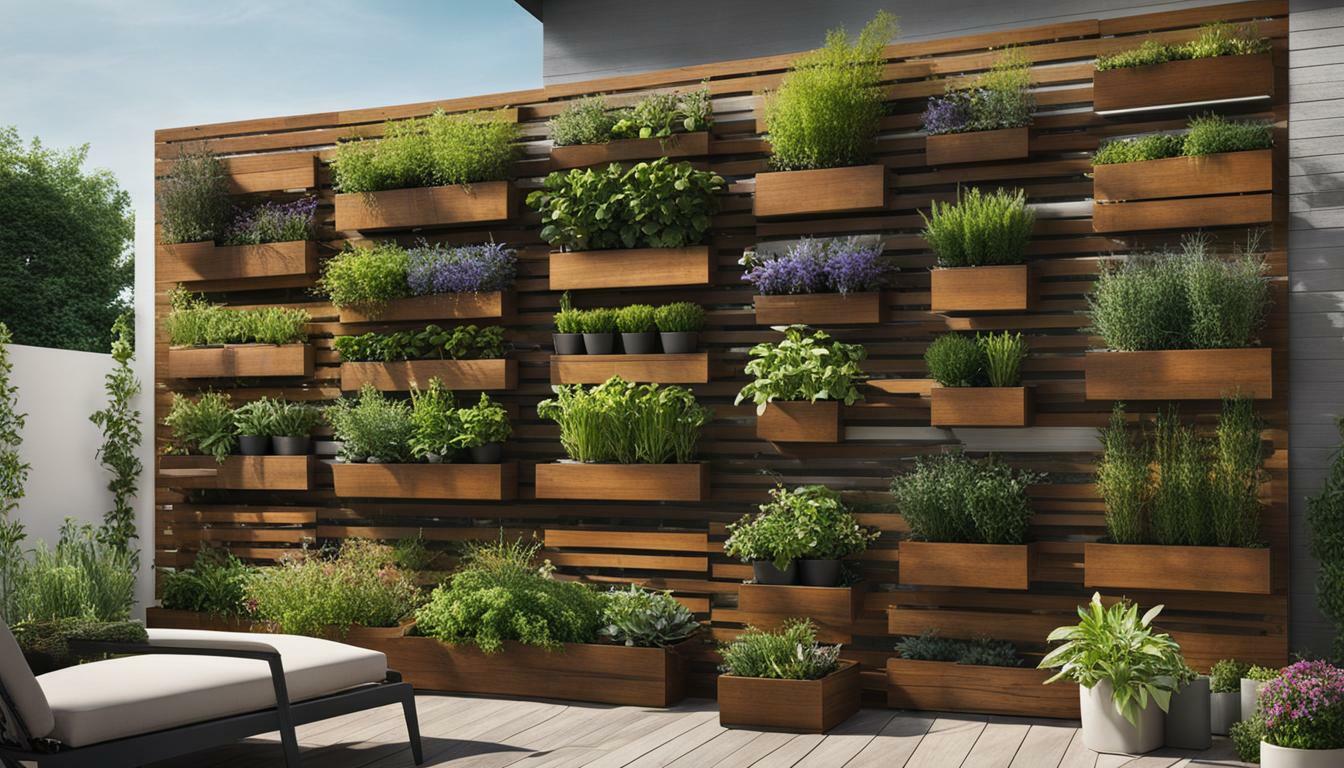Create a lush oasis in even the smallest outdoor spaces with a vertical herb garden. Discover how vertical gardening can help you maximize your outdoor space and enhance your gardening experience.
Vertical gardening is a popular trend, especially in urban spaces where outdoor areas are limited. It allows you to make the most of your space by utilizing vertical surfaces, such as walls, fences, and even trellises, to grow your favorite herbs.
With a vertical herb garden, you can bring greenery and freshness to any outdoor space, no matter how small. Not only does it add beauty and aesthetic appeal, but it also provides you with a convenient way to grow your own herbs, ensuring a constant supply for cooking and adding a touch of nature to your everyday life.
Key Takeaways:
- Create a lush oasis in small outdoor spaces with a vertical herb garden.
- Vertical gardening maximizes your outdoor space and enhances your gardening experience.
- Vertical herb gardens are perfect for urban spaces with limited outdoor areas.
- It brings greenery, freshness, and convenience to your outdoor space.
- Grow your own herbs for cooking and enjoy the benefits of a touch of nature.
Why Choose Vertical Gardening?
Vertical gardening offers endless possibilities for maximizing your outdoor space. Whether you opt for a DIY project or explore innovative vertical garden ideas, you can create a beautiful and functional herb garden. This trend has become increasingly popular in urban spaces, where individuals may have limited outdoor areas like balconies or small backyard gardens. By making use of vertical space, you can transform walls, trellises, fences, and other structures into lush green sanctuaries.
One of the main benefits of vertical gardening is its ability to optimize space. When you have limited ground area, going vertical allows you to grow a wide variety of plants without taking up valuable floor space. You can choose from a range of options, from custom-built modular systems with automatic irrigation to affordable DIY projects using pallet planters mounted on a wall. The choice depends on the needs and budget of your space.
Vertical gardening also offers the opportunity to create a more private outdoor space. By using a vertical garden as a screen around your garden, you can enjoy a secluded and tranquil environment. Additionally, the vertical design of these gardens can enhance the aesthetics of your outdoor space, making it visually interesting and appealing.
When it comes to selecting plants for your vertical garden, it’s essential to consider the specific needs of your space. Factors such as sunlight exposure, water requirements, and overall garden design play a crucial role. For example, if you have a north-facing wall that doesn’t receive much sunlight, opt for hardier plants that can tolerate shade. Alternatively, if you’re creating an herb wall, choose shade-loving herbs such as mint, parsley, or chives.
Overall, vertical gardening offers a practical and creative solution for maximizing outdoor space. Whether you’re looking to create a lush jungle oasis or a simple herb garden, there are endless possibilities to explore. By selecting the right plants, optimizing sunlight and water, and incorporating thoughtful design, you can transform your outdoor area into a stunning vertical garden.
| Advantages of Vertical Gardening | Best Plants for Vertical Gardens |
|---|---|
|
|
“Vertical gardening can be a great way to create more space while showcasing your plants in a new and artful way.” – Luke Dejahang, CEO of Crown Pavillions
DIY Vertical Garden Ideas
If you’re looking to get creative with your vertical garden, there are plenty of DIY options to explore. One popular idea is to use wooden pallets as a planter system. These pallets can be easily mounted on a wall, allowing you to create a vertical garden without breaking the bank. Simply attach pots or planters to the pallets, fill them with your favorite herbs or flowers, and watch your garden come to life. This DIY approach offers a cost-effective and customizable solution for any outdoor space.
Vertical Gardening with Trellises
Another option for vertical gardening is using trellises to support vining plants. Trellises are frames made with materials such as wood, heavy plastics, wire, or metal, which provide a structure for climbing plants to grow. By affixing a trellis to a wall or leaving it freestanding, you can create a visually appealing vertical garden. Plant vines at the base of the trellis and train them to grow upward, maximizing your garden space and adding a beautiful green element to your outdoor area.
Selecting the Right Plants for Your Vertical Garden
When designing your vertical herb garden, it’s crucial to carefully select the plants that will thrive in your space. Consider the design of your garden and the specific needs of herbs to create a successful vertical garden. Whether you’re working with a small balcony or a larger outdoor space, choosing the right plants will ensure that your vertical garden flourishes.
One important factor to consider is the amount of sunlight your vertical garden receives. Some herbs thrive in full sun, while others prefer partial shade. For north-facing walls or areas with limited sunlight, opt for hardier plants that don’t mind a bit of shade, such as fuchsia, hardy geraniums, or ferns. If you’re going for an aromatic herb wall, shade-loving herbs like mint, parsley, or chives are ideal choices.
Another crucial consideration is proper watering. Vertical gardens can dry out quickly, so it’s important to ensure that your plants are getting the correct amount of water. If you have limited time for maintenance, consider investing in an automatic irrigation system to keep your plants healthy and hydrated.
Below is a summary of the best herbs to consider for your vertical herb garden:
| Herb | Sunlight Requirements | Watering Needs |
|---|---|---|
| Mint | Shade | Regular watering |
| Parsley | Shade | Regular watering |
| Chives | Shade | Regular watering |
| Thyme | Full sun | Moderate watering |
| Rosemary | Full sun | Low watering |
| Basil | Full sun | Regular watering |
By selecting herbs that thrive in your specific conditions, you can create a vertical garden that not only looks beautiful but also provides a bountiful harvest of fresh herbs for your culinary adventures.
Expert Tip:
“Vertical gardens offer a unique opportunity to grow herbs and plants in an artful and space-saving manner. By carefully selecting the right plants, you can create a beautiful and functional vertical herb garden that complements your outdoor space.” – Luke Dejahang, CEO of Crown Pavillions
Tips for Maximizing Sunlight and Watering in a Vertical Garden
Achieving optimal sunlight and watering conditions is essential for the success of your vertical herb garden. Discover tips and techniques for maximizing sunlight and creative ideas for creating a stunning vertical garden wall.
1. Make considered plant choices
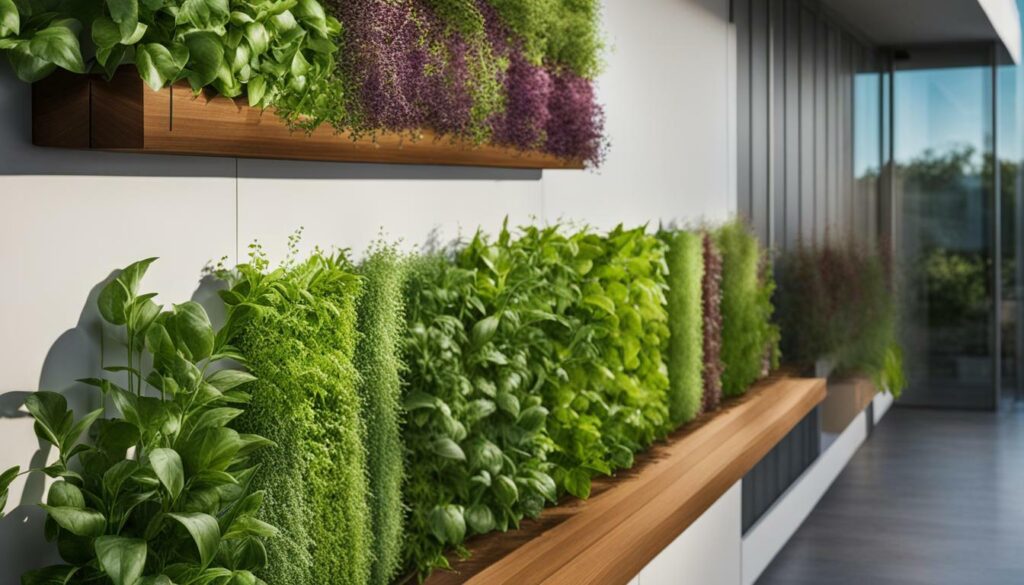
Before planning your vertical garden, it is important to consider which types of plants will thrive in your space. Some plants require more sunlight, while others can tolerate shade. For areas with north-facing walls that receive less direct sunlight, opt for hardier plants such as fuchsia, hardy geraniums, or ferns. Shade-loving herbs like mint, parsley, or chives are great options for creating an aromatic herb wall.
Additionally, ensuring that your plants receive the correct amount of water is crucial. If you have limited time for watering, consider investing in an automatic irrigation system to provide consistent hydration to your plants.
2. Pleach a tree for privacy
Trees can be challenging to fit into a small space, but the technique known as pleaching allows you to train trees to provide vertical interest and privacy. Standard pleached trees are trained on narrow trellis frames above a clear stem, making them perfect for extending screening above a brick wall. Consider using Japanese privet, Photinia x fraseri ‘Red Robin’, or cherry laurel for maximum privacy throughout the year.
3. Combine individual planters for a green wall
If you want to create a living wall effect but lack the resources for a complex irrigated system, attaching multiple containers and hanging baskets to a garden fence is a simple solution. Wall planters and hanging baskets are excellent options for smaller garden areas, such as balcony gardens, as they maximize floor space and create visual interest by drawing the eye upwards.
By carefully selecting your plants, utilizing vertical growing methods, and providing adequate sunlight and water, you can create a stunning vertical garden wall that maximizes your outdoor space and enhances the beauty of your herb garden.
| Tips for Maximizing Sunlight and Watering in a Vertical Garden |
|---|
| Make considered plant choices |
| Pleach a tree for privacy |
| Combine individual planters for a green wall |
Enhancing Privacy and Aesthetics with Vertical Garden Ideas
Vertical garden ideas not only optimize space but also enhance privacy and aesthetics in your outdoor area. Discover how to create a private sanctuary with a vertical privacy fence garden and elevate the design of your space.
When it comes to creating a vertical garden that offers both privacy and beauty, a privacy fence garden is an excellent option. By strategically placing tall plants or climbing vines along a fence or trellis, you can create a natural barrier that provides privacy from neighbors or prying eyes. Choose fast-growing plants like bamboo or ivy to quickly establish a lush, green fence. Not only will this vertical garden idea create a sense of seclusion, but it will also add a touch of natural beauty to your outdoor space.
In addition to privacy, vertical garden design plays a crucial role in enhancing the aesthetics of your outdoor area. By carefully selecting the plants and arranging them in an appealing manner, you can create a visually stunning vertical garden. Consider mixing various colors, textures, and heights of plants to add visual interest and create a dynamic and vibrant display. Incorporate flowering plants, cascading vines, and different foliage shapes to create a multi-dimensional vertical garden that becomes a focal point in your outdoor space.
Benefits of a Vertical Privacy Fence Garden:
- Offers privacy and seclusion from neighbors or passersby
- Creates a natural barrier that enhances security
- Adds a touch of natural beauty and greenery
- Reduces noise pollution
- Provides shade and shelter
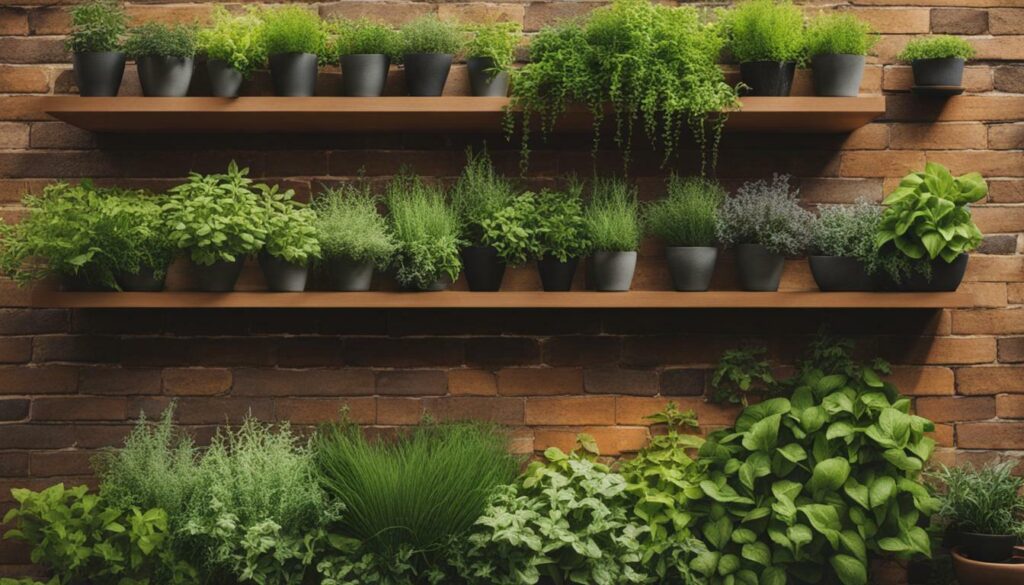
When designing your vertical privacy fence garden, consider the layout and placement of your plants. It’s essential to choose plants that thrive in your climate and are suitable for vertical growth. You can also incorporate other elements such as hanging pots, decorative screens, or even outdoor artwork to further enhance the aesthetics of your vertical garden.
By combining privacy and aesthetics, vertical garden ideas allow you to transform your outdoor space into a private oasis that reflects your personal style and enhances the overall ambiance of your home. Whether you have a small balcony or a spacious backyard, a vertical privacy fence garden can be a beautiful addition that maximizes space and elevates the design of your outdoor area.
| Benefits | Plants for Vertical Privacy Fence Garden |
|---|---|
| Offers privacy and seclusion | Bamboo, Ivy, Wisteria |
| Enhances security | Climbing Roses, Hops, Clematis |
| Adds natural beauty | Trumpet Vine, Bougainvillea, Grapevines |
| Reduces noise pollution | Mexican Orange Blossom, Star Jasmine, Boston Ivy |
| Provides shade and shelter | Passionflower, Morning Glory, Kiwi |
Bringing Vertical Gardening Indoors
Vertical gardening isn’t limited to outdoor spaces. Learn how to bring the beauty of a vertical herb garden indoors and create a tropical oasis within your home.
Indoor vertical gardens are a popular choice for those who want to maximize their space and enjoy the benefits of gardening year-round. With the right plants and design, you can create a stunning vertical herb garden that adds greenery and freshness to your indoor environment.
To create a tropical oasis indoors, choose plants that thrive in low-light conditions and have a lush, tropical appearance. Some popular choices include ferns, pothos, and calatheas. These plants not only add a touch of tropical beauty to your space but also help purify the air and create a soothing and relaxing atmosphere.
When designing your vertical herb garden indoors, consider using wall-mounted planters or hanging baskets to make the most of your vertical space. You can also use shelves or a trellis system to create a multi-level garden that adds depth and interest to your indoor space. Experiment with different plant combinations and arrangements to create a unique and visually stunning display.
Benefits of Vertical Herb Garden Indoors:
| Benefits | Description |
|---|---|
| Maximizes Space | Vertical gardening allows you to utilize unused wall space and make the most of your indoor area. |
| Creates a Tropical Atmosphere | Indoor vertical herb gardens with tropical plants can transform your space into a lush and green oasis. |
| Purifies Indoor Air | Plants have the ability to filter and purify the air, improving indoor air quality and creating a healthier environment. |
| Adds Beauty and Visual Interest | A vertical herb garden adds a unique and visually appealing element to your home decor. |
By bringing vertical gardening indoors, you can enjoy the benefits of gardening even in small spaces. Whether you have a tiny apartment or a spacious home, creating a vertical herb garden can add beauty, freshness, and a touch of nature to your indoor environment.
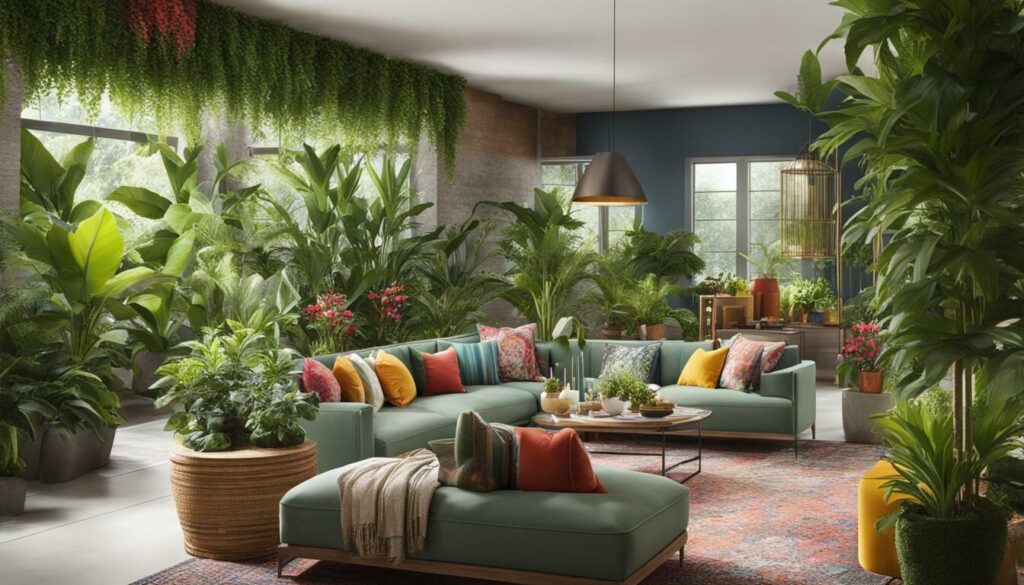
Creative DIY Vertical Garden Ideas
Get inspired by DIY vertical garden ideas and discover how to transform wooden pallets into a stunning planter system for your herbs. Vertical gardening is a popular trend that allows you to maximize your garden space and create a beautiful and functional outdoor area. With a little creativity and some basic tools, you can create a vertical garden using wooden pallets as a cost-effective planter system.
One creative idea is to attach pots or containers to the slats of the pallet, allowing you to grow multiple herbs or plants in a compact space. Simply hang the pallet vertically against a wall or fence, making sure it is securely fastened for stability. This method not only saves space but also adds visual interest to your outdoor area.
Another DIY option is to create a tiered herb garden by stacking multiple pallets vertically. This allows you to grow a variety of herbs in different levels, creating a beautiful and functional display. You can easily customize the size and arrangement of the pallets to fit your space and gardening needs.
When using wooden pallets as a planter system, it’s important to ensure proper drainage for your plants. Drill holes in the bottom of each pot or container to allow excess water to drain out. Additionally, consider lining the pallet with landscaping fabric to prevent soil from falling through the gaps and to help retain moisture.
Benefits of Using Wooden Pallets as a Planter System
Using wooden pallets as a planter system in your vertical garden offers several benefits. First, they are readily available and often free, as many businesses or warehouses discard pallets after use. This makes them a cost-effective option for creating your DIY vertical garden.
Wooden pallets also provide a rustic and natural look to your garden, adding texture and warmth to your outdoor space. They can be easily painted or stained to match your preferred aesthetic or to add a pop of color.
Moreover, the spaces between the slats in the pallets allow for air circulation and root growth, promoting healthy plant growth. The vertical arrangement also maximizes sunlight exposure for your plants, ensuring they receive the necessary light for photosynthesis.
Table: Popular Herbs for Vertical Gardens
| Herb | Description |
|---|---|
| Basil | Popular culinary herb with aromatic leaves |
| Mint | Refreshing herb commonly used in teas and cocktails |
| Parsley | Versatile herb with flat or curly leaves, used as a garnish or in cooking |
| Thyme | Fragrant herb with small leaves, often used in savory dishes |
| Rosemary | Aromatic herb with needle-like leaves, adds flavor to various dishes |
Whether you have limited space or simply want to add a unique touch to your garden, DIY vertical garden ideas using wooden pallets as a planter system offer an innovative and affordable solution. By repurposing pallets, you can create a stunning vertical herb garden that combines functionality with aesthetics. Start your DIY project today and enjoy the beauty and convenience of a vertical garden.
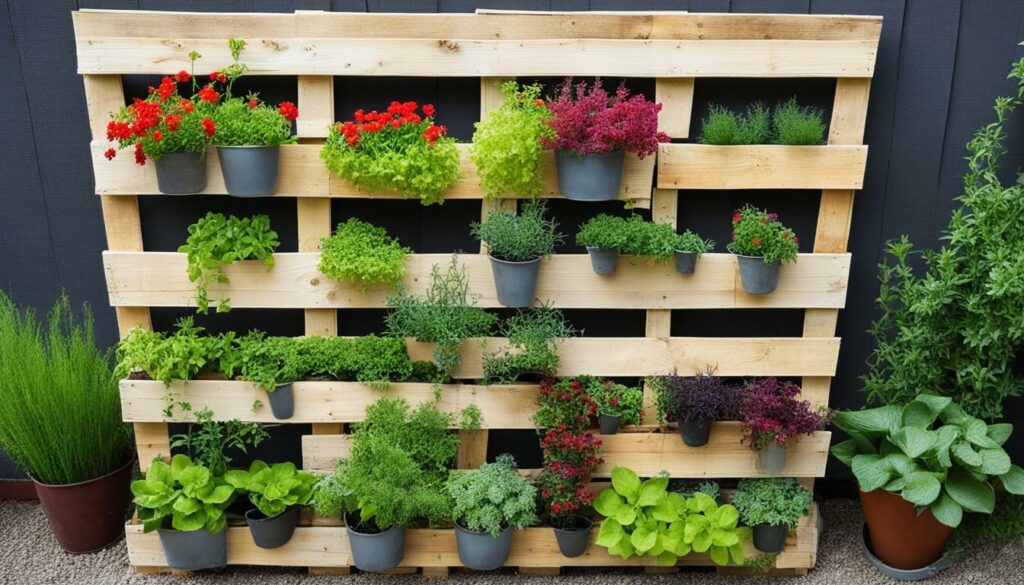
Vertical Gardening with Trellises and Trellis Ideas
Discover how trellises can elevate your vertical gardening experience and learn about different trellis ideas for growing vining plants in your outdoor space. Vertical gardening with trellises provides an efficient and space-saving way to grow vegetables, herbs, and flowers. By utilizing vertical space, you can maximize your garden’s potential and create a visually appealing and productive garden.
One trellis idea for vertical gardening is to use mesh lattice trellises. These frames, made from various materials such as wood, heavy plastics, wire, or metal, provide support for climbing plants. You can affix them to exterior walls or leave them freestanding to lean against another structure. Planting vines at the base of the trellis and weaving them through the mesh allows them to grow upward. This method not only maximizes space but also produces high-quality fruits and vegetables while preventing pests and diseases.
Another trellis idea is to create green walls of container plants. With this approach, you can affix pots or wall planters to fencing, exterior walls, or freestanding structures. Container gardening offers versatility, allowing you to grow a variety of plants, including flowers, herbs, and vegetables. It’s important to choose the right size container and use a nutrient-rich soil mix to ensure optimal plant growth. Maintaining container plants may require frequent watering and fertilizing, but the individual care is more accessible than in traditional in-ground gardens.
If you’re interested in hydroponic gardening, consider hydroponic living walls for your vertical garden. Hydroponics involves growing plants without soil, using nutrient-rich water as the growing medium. Vertical gardens with hydroponic systems can be set up using PVC pipes, towers, gutters, or other containers. These systems provide many benefits, such as increased property value, reduced air and water pollution, and lower energy bills. Maintenance is minimal, with regular checks on the plants and water levels. Common hydroponic crops include fruits, flowers, herbs, and vegetables.
| Trellis Ideas | Best Plants to Grow |
|---|---|
| Mesh lattice trellises | Fruit: Blackberries, Grapes, Raspberries Flowers: Clematis, Honeysuckle, Morning glories Herbs: Nasturtium, Passion Flower, Star Jasmine Vegetables: Cucumbers, Melons, Pole beans |
| Green walls of container plants | Fruit: Citrus, Figs, Alpine Strawberries Flowers: Coleus, Geraniums, Phlox Herbs: Basil, Cilantro, Rosemary Vegetables: Broccoli, Eggplant, Tomato |
| Hydroponic living walls | Fruit: Currants, Strawberries, Watermelons Flowers: Impatiens, Petunias, Wallflowers Herbs: Chives, Parsley, Sage Vegetables: Bell Peppers, Lettuce, Spinach |
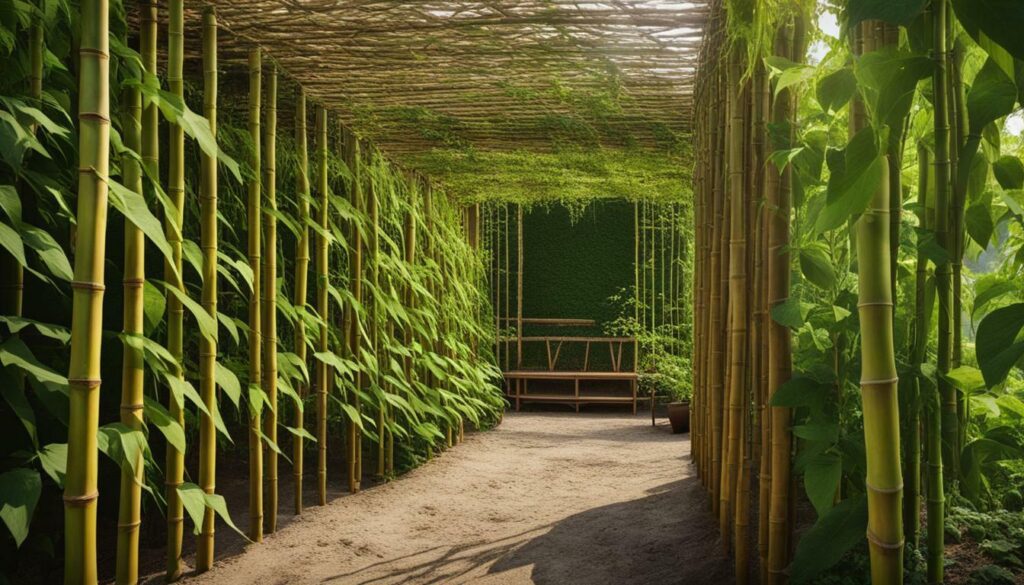
Vertical gardening with trellises offers a versatile and aesthetically pleasing way to grow vining plants in your outdoor space. Whether you choose mesh lattice trellises, green walls of container plants, or hydroponic living walls, you can create a thriving vertical garden that maximizes space and productivity. Experiment with different trellis ideas and plant selections to find the perfect combination for your vertical gardening adventure.
Conclusion
By optimizing your outdoor space with a vertical herb garden, you can create a lush, functional, and visually appealing garden. Vertical gardening offers a range of benefits, making it a popular choice for small spaces, urban gardens, and those looking to maximize their outdoor area.
With a vertical garden, you can make use of wall space and create a jungle oasis without sacrificing valuable floor space. Whether you choose to build a custom modular system or opt for DIY options like pallet planters, vertical gardening allows you to showcase your plants in a new and artful way.
When selecting plants for your vertical garden, consider the specific needs of your space and the plants’ requirements for sunlight and water. By choosing the right plants, you can ensure that your vertical garden thrives and adds beauty to your outdoor area.
Vertical gardening is not limited to outdoor spaces. You can also bring the concept indoors and create a tropical oasis in your home. By utilizing the benefits of vertical gardening, you can enhance privacy and aesthetics in both outdoor and indoor spaces.
Get creative with DIY vertical garden ideas, such as using wooden pallets as a planter system or incorporating trellises for vining plants. These cost-effective solutions can add charm and functionality to your vertical garden.
Overall, vertical gardening offers a versatile and practical solution for maximizing space and creating a visually stunning garden. Whether you have a small balcony or a spacious backyard, incorporating a vertical herb garden can transform your outdoor area into a vibrant and thriving oasis.
Are Vertical Herb Gardens Specifically Designed for Outdoor Use?
Yes, vertical herb gardens are specifically designed for outdoor use, as they help maximize space. By growing herbs vertically, you can make the most of your outdoor area and enjoy a diverse range of plants without taking up too much space.
FAQ
Q: What is vertical gardening?
A: Vertical gardening is a method of arranging plants in a way that they grow vertically, using structures such as trellises, walls, or containers. It maximizes space and allows for the growth of plants in small or limited areas.
Q: Why should I choose vertical gardening?
A: Vertical gardening is a great choice for optimizing space in outdoor areas. It allows you to create a garden even in small spaces and provides opportunities for creative DIY projects. Vertical gardens can also enhance privacy and aesthetics in outdoor spaces.
Q: How do I select the right plants for my vertical garden?
A: When selecting plants for a vertical garden, consider factors such as the amount of sunlight the area receives and the watering needs of the plants. Choose plants that are suitable for vertical growth and can thrive in the conditions of your vertical garden.
Q: How can I maximize sunlight and watering in my vertical garden?
A: To maximize sunlight in a vertical garden, consider the placement of your garden and choose plants that can tolerate different light levels. To ensure proper watering, you can use an automatic irrigation system or hand-water your plants as needed. Additionally, consider the design and structure of your vertical garden to optimize sunlight exposure and water distribution.
Q: How can vertical garden ideas enhance privacy and aesthetics in outdoor spaces?
A: Vertical garden ideas, such as privacy fence gardens, can provide a natural barrier and enhance privacy in outdoor spaces. Additionally, vertical gardens can add visual interest and beauty to any outdoor area, creating a unique and artful display of plants.
Q: Can I bring vertical gardening indoors?
A: Yes, vertical gardening can be brought indoors to create a tropical oasis. Indoor vertical gardens can be used to enhance the aesthetics of your indoor spaces and provide a relaxing and healthy environment. Select plants that thrive indoors and create a vertical herb garden to enjoy fresh herbs year-round.
Q: What are some creative DIY vertical garden ideas?
A: One creative DIY vertical garden idea is to use wooden pallets as a planter system. By attaching planters to the reverse side of pallets, you can create a wall-mounted planting system. This cost-effective solution maximizes space and adds a unique touch to your garden.
Q: How can trellises be used in vertical gardening?
A: Trellises are commonly used in vertical gardening to support the growth of vining plants. They can be affixed to walls or left freestanding to lean against structures. Trellises provide a framework for plants to climb and maximize vertical growing space.

